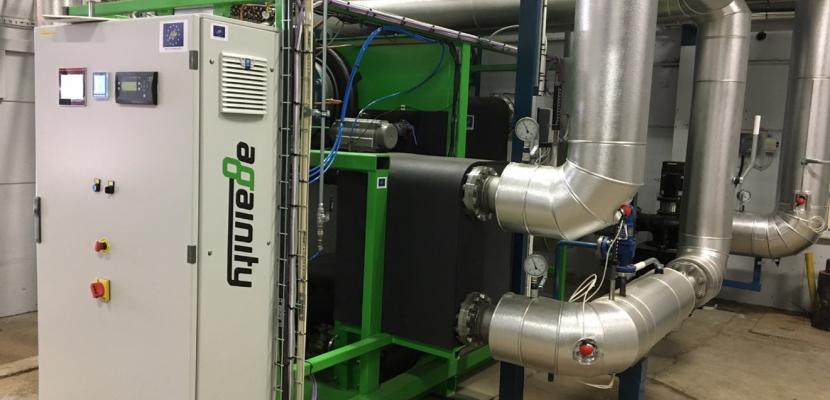Image

Organic Rankine Cycle (ORC) for heat and power production
Published on 29 March 2021

Sweden
This is the good practice's implementation level. It can be national, regional or local.
About this good practice
Ronneby Miljö & Teknik AB (Ronneby Environment & Technology AB) is a municipal company that is wholly-owned by the municipality of Ronneby. They manage power, heat, water, sewage, sanitation, fiber optic networks and broadband.
In the small community of Bräkne-Hoby, an ORC (Organic Rankine Cycle) has been installed in the previously existing biofuel boiler supplying heat for the district heating network and a wood dryer. The ORC unit produces heat through a heat exchanger and electricity via a turbine. By connecting the ORC unit to the boiler plant, the heat deliveries can be optimized while green, renewable electricity is produced.
The organic Rankine cycle operates with an organic working fluid of a lower evaporation temperature compared to a conventional steam process, but without the risk of moisture vapor and corrosion and erosion in the turbine or expander. The internal working medium needs a heat source over 90○ connected to the evaporator. After passing through the turbine, the organic working medium is cooled down in the condenser connected to either a district heating network, air cooling system or other cooling water.
Due to the use of an organic medium with a higher density than water vapor in the turbine loop, a turbine more compact than a conventional steam cycle can be used. However, by working with small temperature differences, the ORC has a limited power exchange.
In the small community of Bräkne-Hoby, an ORC (Organic Rankine Cycle) has been installed in the previously existing biofuel boiler supplying heat for the district heating network and a wood dryer. The ORC unit produces heat through a heat exchanger and electricity via a turbine. By connecting the ORC unit to the boiler plant, the heat deliveries can be optimized while green, renewable electricity is produced.
The organic Rankine cycle operates with an organic working fluid of a lower evaporation temperature compared to a conventional steam process, but without the risk of moisture vapor and corrosion and erosion in the turbine or expander. The internal working medium needs a heat source over 90○ connected to the evaporator. After passing through the turbine, the organic working medium is cooled down in the condenser connected to either a district heating network, air cooling system or other cooling water.
Due to the use of an organic medium with a higher density than water vapor in the turbine loop, a turbine more compact than a conventional steam cycle can be used. However, by working with small temperature differences, the ORC has a limited power exchange.
Expert opinion
This good practice of technical nature consists in using waste heat available at e.g. a district heating boiler to produce electricity onsite with an ORC (organic rankine cycle) method.
The value to policy makers consists in the awareness of such solutions: it is technically fully possible to turn heat into electricity. This invites reflections about potential heat sources that are un-used or under-used at certain times or in general as they can be used to produce electricity in a cost-efficient way as simple add-on to the existing boiler or similar thermal power unit.
The value to policy makers consists in the awareness of such solutions: it is technically fully possible to turn heat into electricity. This invites reflections about potential heat sources that are un-used or under-used at certain times or in general as they can be used to produce electricity in a cost-efficient way as simple add-on to the existing boiler or similar thermal power unit.
Works at
Interreg Europe Policy Learning Platform
Resources needed
The ORC needs a hot water or steam boiler with a heat capacity between 2-50 MW. The installation is simple, just two pipes connected to the boiler and two pipes connected to the district/local heating network.
The system is robust with few moving parts, which means minimal maintenance and service.
The system is robust with few moving parts, which means minimal maintenance and service.
Evidence of success
Effect: 45 kW electricity
Operating hours/year: 4000 h
Electricity production/year: Approximately 260 MWh
Investment cost: Approximately € 120 000
Feed-stock: Wood chips, forest residue, bark etc.
Moisture in feed-stock: 35-50 %
Model: Againity AT50
Dimensions: 2,5 x 1,14 x 2 meters
Pay-back period: approximately ten years
Operating hours/year: 4000 h
Electricity production/year: Approximately 260 MWh
Investment cost: Approximately € 120 000
Feed-stock: Wood chips, forest residue, bark etc.
Moisture in feed-stock: 35-50 %
Model: Againity AT50
Dimensions: 2,5 x 1,14 x 2 meters
Pay-back period: approximately ten years
Potential for learning or transfer
The technology facilitates upgrading a plant to a combined heat and power plant if there is an exisiting heating plant with a hot water or steam boiler . When you produce your own electricity this way you reduce your energy bills and contribute to a greener and more weather-independent energy system.
There are approximately 20 ORCs installed in Sweden (2021). Some of them are open for study visits, in real or virtually. For contact details, visit the webpage.
There are approximately 20 ORCs installed in Sweden (2021). Some of them are open for study visits, in real or virtually. For contact details, visit the webpage.
Further information
Website
Good practice owner
You can contact the good practice owner below for more detailed information.
Organisation
other

Sweden
Småland med öarna
